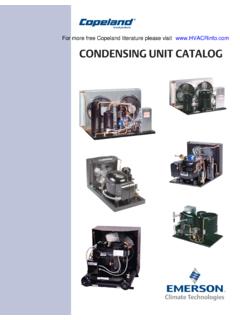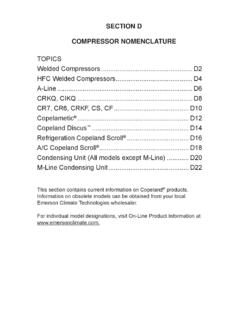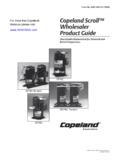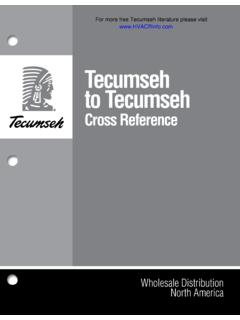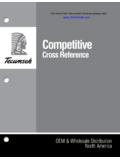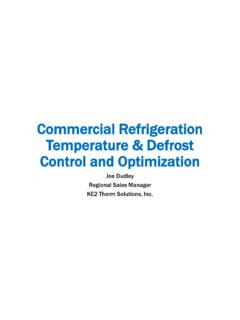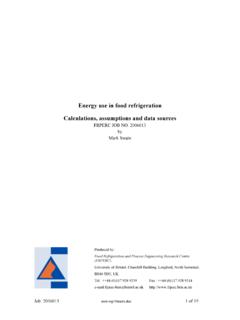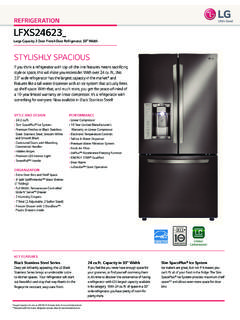Transcription of Refrigeration Manual - HVAC
1 Refrigeration Manual Part 2 - Refrigeration System Components This is the second of a series of publications comprising the Emerson Climate Technologies, Inc. Refrigeration Manual , and follows Part 1, Fundamentals of Refrigeration .. The information included on Refrigeration components is general in nature and is intended only to give a brief description of their operation. Detailed information as to specific products is available from manufacturers of components and accessories. 1967 Emerson Climate Technologies, Inc. All rights reserved. Part II. Refrigeration SYSTEM COMPONENTS. Section 4. COMPRESSORS Section 7. CONTROL DEVICES, REFRIGERANT. Reciprocating 4-1 Thermostatic Expansion 7- 1. Open Type 4-2 Other Types of Expansion 7- 2. Accessible-Hermetic 4-2 7- 2. Welded Hermetic 4-2 Capillary 7- 2. Compressor 4-2 Float 7- 8. Basic Compressor 4-4 Solenoid 7- 8. Suction and Discharge 4-4 Crankcase Pressure Regulating 7- 9. Compressor 4-4 Evaporator Pressure Regulating 7- 9.
2 Clearance 4-4 Hot Gas Bypass 7- 9. 4-5 Reversing 7-10. Dry Air Holding 4-6 Check 7-10. Compressor 4-6 Manual Shut-Off 7-11. Compressor 4-6 Compressor Service 7-11. Two Stage 4-6 Schrader Type 7-11. Compressors with Unloaders .. 4-7 Pressure Relief 7-12. Tandem 4-7 Fusible 7-12. Water Regulating 7-12. Section 5. CONDENSERS. Section 8. CONTROL DEVICES, ELECTRICAL. Air Cooled 5-1. Water Cooled 5-2 Control 8-1. Evaporative 5-4 Line Voltage and Low Voltage 8-1. Condenser 5-5 Low Pressure and High Pressure 8-1. Condensing 5-5 Condenser Fan Cycling 8-2. Non-Condensable 5-5 8-2. Condensing Temperature 5-6 Oil Pressure Safety 8-2. Time 8-2. Section 6. EVAPORATORS 8-3. Time Delay 8-3. Types of 6-1 8-3. Blower Coil 6-1. Pressure Drop and Other Factors in Evaporator 6-2. Evaporator 6-2. Temperature Difference and 6-2. Defrosting of Blower 6-3. 1. 1967 Emerson Climate Technologies, Inc. All rights reserved. Section 9. MOTORS Motor 10-8. Internal Inherent Line Break 10-8.
3 Motor 9-1 External Inherent 10-9. Open Type Motors and Belt 9-1 Internal 10-9. Hermetic 9-2 External 10-9. Nameplate 9-2 Current Sensitive 10-9. Voltage and 9-3 10-9. Three Phase 9-3 Solid State 10-9. Single Phase 9-3 Fuses and Circuit 10-9. Split Phase 9-3 Effect of Unbalanced Voltage and Current Capacitor Start-Induction Run Motors on Three Phase Motor 10-10. (CSIR).. 9-4. Capacitor Start-Capacitor Run Motors Section 11. ACCESSORIES. (CSR).. 9-4. Permanent Split Capacitor Motors (PSC).. 9-5 11-1. Dual Voltage 9-5 Heat 11-1. Two Phase 9-6 Suction 11-1. Oil 11-2. Section 10. STARTING EQUIPMENT AND MOTOR 11-2. PROTECTORS Suction Line 11-2. Vibration 11-2. Contactors and 10-1 11-3. 10-1 Sight Glass and Moisture 11-3. Start 10-2 Discharge 11-3. Run 10-2 Crankcase 11-3. Reduced Voltage 10-3 Refrigeration 11-4. 1967 Emerson Climate Technologies, Inc. All rights reserved. Section 4. COMPRESSORS. The compressor has two functions in the compression RECIPROCATING COMPRESSORS.
4 Refrigeration cycle. First it removes the refrigerant vapor from the evaporator and reduces the pressure in the The design of the reciprocating compressor is somewhat evaporator to a point where the desired evaporating similar to a modern automotive engine, with a piston temperature can be maintained. Second, the compressor driven from a crankshaft making alternate suction raises the pressure of the refrigerant vapor to a level and compression strokes in a cylinder equipped with high enough so that the saturation temperature is higher suction and discharge valves. Since the reciprocating than the temperature of the cooling medium available compressor is a positive displacement pump, it is suitable for condensing the refrigerant vapor. for small displacement volumes, and is quite efficient at high condensing pressures and high compression ratios. There are three basic types of compressors; reciprocating, Other advantages are its adaptability to a number of rotary, and centrifugal.
5 Centrifugal compressors are different refrigerants, the fact that liquid refrigerant may widely used in large central air conditioning systems, be easily run through connecting piping because of the and rotary compressors are used in the domestic high pressure created by the compressor, its durability, refrigerator field, but the overwhelming majority of basic simplicity of design, and relatively low cost. compressors used in the smaller horsepower sizes for commercial, domestic, and industrial applications An exploded view of a typical Copelametic accessible- are reciprocating, and this Manual will cover only hermetic motor-compressor is shown in Figure 10. reciprocating compressors. 4-1 1967 Emerson Climate Technologies, Inc. All rights reserved. OPEN TYPE COMPRESSORS WELDED HERMETIC MOTOR-COMPRESSORS. Early models of Refrigeration compressors were of the In an effort to further decrease size and cost, the welded so-called open type, with the pistons and cylinders sealed hermetic motor-compressor has been developed, and within a crankcase, and a crankshaft extending through is widely used in small horsepower unitary equipment.
6 The body for an external power source. A shaft seal As in the case of the accessible-hermetic motor- around the crankshaft prevented the loss of refrigerant compressor an electric motor is mounted directly on the and oil from the body. compressor crankshaft, but the body is a formed metal shell hermetically sealed by welding. No internal field Although at one time open type compressors were widely repairs can be performed on this type of compressor used, they have many inherent disadvantages such as since the only means of access is by cutting open the greater weight, higher cost, larger size, vulnerability to compressor shell. seal failures, difficult shaft alignment, excessive noise, and short life of belts or direct drive components. As a result, the open type compressor has been largely replaced with the accessible-hermetic and hermetic type motor-compressor in most applications, and the use of open type compressors continues to decline except for specialized applications such as automobile air conditioning.
7 ACCESSIBLE-HERMETIC MOTOR- COMPRESSORS. The accessible-hermetic motor-compressor design was pioneered by Emerson Climate Technologies, Inc. and is widely used in the popular Copelametic models. The compressor is driven by an electric motor mounted directly on the compressor crankshaft, with both the motor COMPRESSOR SPEED. and the compressor working parts hermetically sealed within a common enclosure. The troublesome shaft seal Early models of compressors were designed for relatively is eliminated, motors can be sized specifically for the slow speed operation, well below 1,000 RPM. In order load to be handled, and the resulting design is compact, to utilize standard 4 pole electric motors, accessible- economical, efficient, and basically maintenance free. hermetic and hermetic motor-compressors introduced operation at 1,750 RPM (1,450 RPM on 50 cycle). The Removable heads, stator covers, bottom plates, and increasing demand for lighter weight and more compact housing covers allow access for easy field repairs in air conditioning equipment has been instrumental in the the event of compressor damage.
8 Development of hermetic motor-compressors equipped with 2 pole motors operating at 3,500 RPM (2,900 RPM. on 50 cycle). Specialized applications such as aircraft, automotive, or military air conditioning equipment utilize even higher speed compressors, but for the normal commercial and domestic application, the existing 60 cycle electric power supply will generally limit compressor speeds to the presently available 1,750 and 3,500 RPM. Higher compressor speeds introduce lubrication and life problems, and these factors as well as cost, size and weight must be considered in compressor design and application. (continued on p. 4-4). 1967 Emerson Climate Technologies, Inc. All rights reserved. 4-2. CROSS-SECTIONAL VIEW OF COPELAMETIC MOTOR-COMPRESSOR. 4-3 1967 Emerson Climate Technologies, Inc. All rights reserved. BASIC COMPRESSOR OPERATION Technologies, Inc. publishes the displacement of a compressor in terms of cubic feet per hour, but some A cross-sectional view of a typical Copelametic motor- manufacturers rate their compressors in terms of compressor is shown in Figure 13.
9 Following is a brief cubic inch displacement per revolution, or in cubic feet description of its operation. per minute. For comparative purposes, compressor displacement may be calculated by the following As the piston moves downward on the suction stroke, formulas: pressure is reduced in the cylinder. When the pressure falls below that in the compressor suction line, the Displacement pressure differential causes the suction valves to open and forces the refrigerant vapor to flow into the CFM = x D x L x RPM x N. cylinder. 4 x 1728. CFH = x D x L x RPM x N x 60. As the piston reaches the bottom of its stroke and 4 x 1728. starts upward on the compression stroke, pressure is Cu. = x D x L x N. developed in the cylinder, forcing the suction valves 4. closed. The pressure in the cylinder continues to rise as the piston moves upward, compressing the vapor Conversion Factors trapped in the cylinder. When the pressure in the cylinder exceeds the pressure existing in the compressor 1750 RPM 3500 RPM.
10 Discharge line, the discharge valves are forced open, CFH = 60 x CFM 60 x CFM. and the compressed gas flows into the discharge line CFH = x x and on into the condenser. Cu. Cu. CFM = x x When the piston starts downward, the reduction in Cu. Cu. pressure allows the discharge valves to close because Cu. = .01645 x CFH .00823 x CFH. of the higher pressure in the condenser and discharge CFM = Cubic feet per minute line, and the cycle is repeated. CFH = Cubic feet per hour Cu. = Cubic inch displacement per For every revolution of the crankshaft, there is both a revolution suction and compression stroke of each piston, so in = 1,750 RPM motor-compressors there are 1,750 complete D= Cylinder bore, inches compression and suction cycles in each cylinder each L= Length of stroke, inches minute, and in 3,500 RPM motor-compressors, 3,500 N= Number of cylinders complete cycles each minute. RPM = Revolutions per minute 1728 = Cubic inches per cubic foot SUCTION AND DISCHARGE VALVES D = Area of a circle 4.


